MUSEUM HAPPENINGS: MoMA
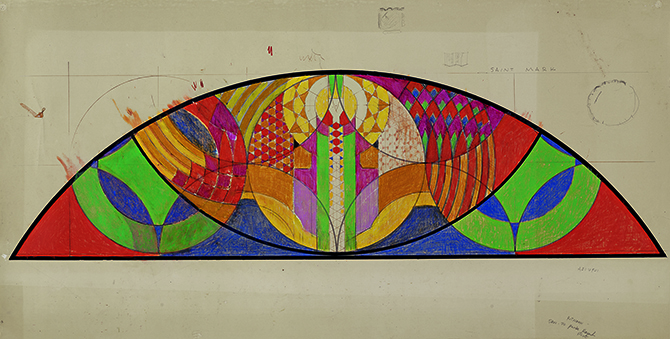 Annunciation Greek Orthodox Church, Wauwatosa, WI, 1955–61
Annunciation Greek Orthodox Church, Wauwatosa, WI, 1955–61By Clint Brownfield
There are all sorts of art exhibits running at any given time in the five boroughs of New York City—from small galleries on up to the city’s major museums, making our city the undisputed art capital of the world. Some of these exhibits are called blockbusters. Frank Lloyd Wright at 150: Unpacking the Archive at The Museum of Modern Art (MoMA) is a must-see which runs through October 1st. The exhibit includes approximately 450 objects from the Frank Lloyd Wright Archives at The Museum of Modern Art and the Avery Architectural Fine Arts Library at Columbia University, to mark the 150th anniversary of Wright’s birth in Richland Center, Wisconsin.
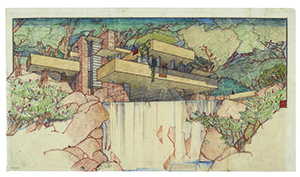 Fallingwater (Kaufmann House), Mill Run, PA, 1934–37
Fallingwater (Kaufmann House), Mill Run, PA, 1934–37PRESERVING THE PAST
As America’s most famous architect/designer, many would agree he was the best. The American Institute of Architects (AIA), which was founded in 1857 by a group of 13 architects including Richard Morris Hunt (Metropolitan Museum and the base of the Statue of Liberty among other projects) continues to this day as the profession’s most prestigious membership organization. It currently lists 17 of Wright’s works as national treasures which must be saved. The list includes perhaps his most famous work Fallingwater, a spectacular private residence in Mill Run, PA, which can be toured today.
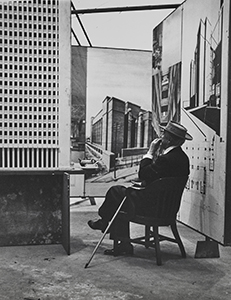 Sixty Years of Living Architecture
Sixty Years of Living ArchitectureThe Work of Frank Lloyd Wright
in New York. 1953. Copyright 2017 Pedro E. Guerrero Archives.
More than a half-century after his 1959 death in Phoenix, AZ, Wright remains America’s most prolific architect. In a career spanning seven decades, he designed more than 1,000 buildings—more than 500 were built. Wright preserved most of his drawings, despite some tragic losses to fires, to form an archive that he hoped would perpetuate his architectural philosophy, first as a tool in the production of architecture in the Taliesin Fellowship, an apprenticeship program he founded in the 1930s. The archive was progressively cataloged and opened to specialists by the Frank Lloyd Foundation, and in 2012, The Museum of Modern Art and Avery Architectural & Fine Arts Library at Columbia University jointly acquired the archive. This exhibit celebrates this pioneering collaboration and the new accessibility of the collection to both scholars and the general public.
Unpacking the Archive refers to the monumental task of moving across the country 55,000 drawings, 300,000 sheets of correspondence, 125,000 photographs, and 2,700 manuscripts, as well as models, films, and building fragments. It also refers to the work of interpretation and the close examination of projects that in some cases have received little attention.
Seeing Wright’s works are very rewarding. The use of color and his distinctive style of drawing is nothing short of spectacular. Even the hand lettering in the drawings is done so that there is no mistaking that
they are the work of this American master.
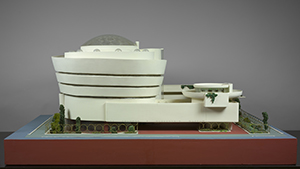 Solomon R. Guggenheim Museum, New York. 1943–59
Solomon R. Guggenheim Museum, New York. 1943–59ICONIC STRUCTURES
If you appreciate architectural models you will be in luck at the exhibition. There are a number of them on view, including one depicting a version of his masterpiece here in New York City: The Solomon R. Guggenheim Museum at Fifth Avenue and 89th Street. Another eye-catching model is one depicting the Price Tower (completed in 1956), a nineteen-story, 221-foot-high building in Bartlesville, OK, and is the only realized skyscraper by Wright. It’s one of only two vertically-oriented Wright structures in existence today. Price Tower also features Inn at Price Tower, an intimate hotel with 19 guest rooms that occupies seven of the tower’s upper floors.
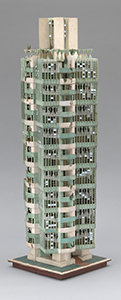 St. Mark’s Tower, New York. Project, 1927–29
St. Mark’s Tower, New York. Project, 1927–29Wright was also a master designer, creating most if not all of the objects used in the interiors and exteriors of his homes and buildings. The exhibition features prime examples of his designs including components, textiles, stained glass, furniture, lighting fixtures and just about any other thing you can think of that makes his work “Classic Wright” to this day. One of his main hallmarks was to integrate the surrounding environment into each of his works. For example, much of the glass made for Taliesin West in Phoenix, AZ was created from the sand surrounding the compound. You can’t get much more organic than that.
In addition to the objects in the exhibition myriad, special activities will be offered at the museum through October 1st. Films, seminars, lectures, and hands-on activities for all ages will provide additional insight into the life and work of America’s most famous architect—Frank Lloyd Wright.
For more information Frank Lloyd Wright at 150: Unpacking the Archive, visit moma.org.

Clint Brownfield is a travel, food and beverage writer and has reported from all seven continents, more than 100 countries and 45 states. He is based in New York City—his favorite destination in the world.



